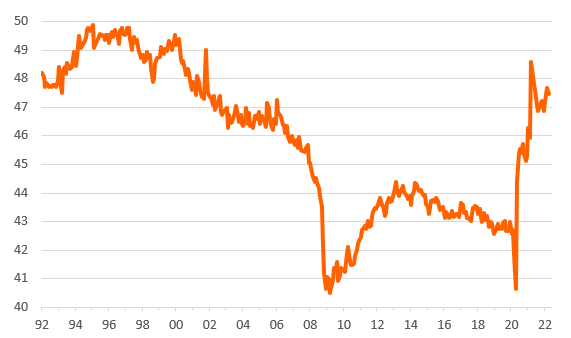US retailers see signs of softening demand
US retail sales were softer in May and there were downward revisions to April. Nonetheless, consumer spending can still grow strongly in the second quarter given a greater focus on services such as leisure and entertainment. However, the cost of living squeeze means households are running down savings and borrowing more to finance it
Retail sales dip in May as car sales falter
US May retail sales are softer than expected, falling 0.3% month-on-month (consensus +0.1%) while April was revised down to 0.7% from 0.9%. Autos were the main drag (-3.5% MoM), which was something we already knew given the unit auto sales numbers released a couple of weeks ago. However, we also saw furniture sales fall 0.9% and electronics dropped 1.3%. These are areas that tend to be correlated with housing activity so with mortgage applications and new home sales down sharply this could be related since new home buyers tend to have to purchase new floorings and curtains and maybe a new TV.
Miscellaneous (-1.1%) and non-store (-1%) were also weak with the main strength coming from gasoline (+4%) due to higher prices. Unfortunately, the overall outcome is quite a disappointing and is likely to lead to a scaling back of expectations for 2Q GDP.
Level of USD retail sales versus February 2020

Consumers are reorienting towards services
Despite the disappointment his leaves retail sales running 27.9% above the February 2020 level, massively outperforming spending on services given the limited options available for leisure and recreation during the pandemic. Retail sales currently account for around 48% of total consumer spending, which as the chart below shows is well above typical proportion seen over the past 20 years. We expect this to shrink again over the coming year as consumers re-prioritise their spending towards services. Importantly, this means that we can see some falls in retail sales, yet broader consumer spending can still rise given a greater number of options on which to spend money.
Retail sales have accounted for a greater proportion of total consumer spending (%)

2H will be more challenging for consumer spending
Admittedly, consumer confidence is weak as households worry about the rising cost of living, but more importantly the data shows they continue to spend. Employment is posting decent gains with wages rising in nominal terms while households seem prepared to run down some of their accumulated savings or use credit cards to maintain lifestyles. This should mean we get a respectable contribution to 2Q GDP growth from consumption with the economy expanding at close to 4% annualized rate overall, but it can’t last forever.
The second half of the year is going to be more challenging. Rising borrowing costs, falling equity markets (and household wealth) and concerns about the outlook for the housing market all risk dampening spending. At the same time there is evidence that the rate of wage inflation is slowing, which will mean ongoing erosion of spending power. So, for spending to continue growing strongly we will need to see households run down their savings or accumulate debt at an even faster rate, which we increasingly doubt will happen.
This publication has been prepared by ING solely for information purposes irrespective of a particular user's means, financial situation or investment objectives. The information does not constitute investment recommendation, and nor is it investment, legal or tax advice or an offer or solicitation to purchase or sell any financial instrument. Read more
Download
Download article